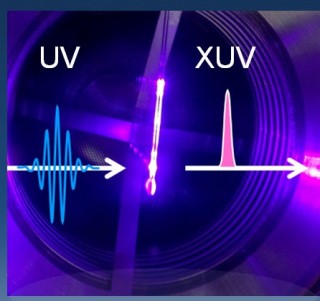Jun 12 2015
Researchers at the Lawrence Berkeley National Laboratory (Berkeley Lab) have developed an innovative way to produce a high-repetition-rate extreme-UV (XUV) light source for acquiring sharp images of a material’s electronic structure. This would help study ultrafast materials dynamics.
 Berkeley Lab researchers have developed a way to produce high-repetition-rate XUV light for obtaining rapid, sharp images of a material’s electronic structure.
Berkeley Lab researchers have developed a way to produce high-repetition-rate XUV light for obtaining rapid, sharp images of a material’s electronic structure.
Snapshots of rapid electronic interactions in materials can aid understanding of the emergence of new phases in materials, such as nanoscale electronic order and high-temperature superconductivity. Delivering extremely short-wavelength UV light pulses to a material could help obtain data about the emitted electron’s travel direction and energy. This would help analyze how novel phases emerge.
"Like taking a photo on a bright day as opposed to dim twilight, if you have a bright laser source, you can cut down the measurement noise and take excellent data because you have a lot of photons to work with" says Robert Kaindl, a condensed matter physicist with Berkeley Lab’s Materials Sciences Division, who led the work. “But there’s a catch: for experiments such as photoemission the light has to be distributed across as many pulses as possible, to avoid unwanted blurring of the measured spectra.”
Angle-resolved photoemission spectroscopy (ARPES) is used in the study of condensed matter materials, and it is based on the photoelectric effect. Information about the momentum space and energy of the electronic structure of a material can be obtained using this method. However, interaction between electrons occurs in a very fast timescale. Static measurements are usually made using customary detectors, but the timescale on which they function is slower by approximately ten trillion times. Electron interaction takes place at microscopic timescales, which require very short pulses of light in the range of 10 to 100 femtoseconds for analysis.
Materials also possess work function, which the light’s photon energy must be capable of overcoming. Light of shorter wavelengths enables a more complete view of a material’s electronic structure across its momentum and energy.
Time-resolved ARPES must be able to generate XUV light of short-wavelength, and also pulse the light at rapid intervals but with few photons per pulse, so that blurring due to electron-electron interaction is minimized.
“It’s very difficult to generate XUV light in the first place. This is made possible by a process called high-harmonic generation, where you expose atoms to extremely strong laser fields with peak intensities of 100 Terawatts or more,” explains He Wang, who developed the source as a postdoctoral researcher at Berkeley Lab while working with Kaindl. “An electron can then tunnel out of the atom and return having picked up a lot of energy that, subsequently, it can lose by emitting an XUV photon. An important result of our work is that we achieve very efficient high-harmonic conversion into the XUV, despite operating at high repetition rates where the driving laser power has to be divided among many pulses.”
Infrared pulses emitted by an amplified femtosecond laser are initially converted into UV, and then, through high-harmonic conversion, acquire back orders-of-magnitude in efficiency. When laser of 50,000 pulses/second is used, the weak UV-driving pulses have to be concentrated into a Krypton gas column where high-harmonic generation takes place. When compared to the efficiency obtained when the infrared laser is used to directly drive the process, this transitional step boosts XUV conversion efficiency by more than one hundred times.
A very bright XUV source flux was demonstrated by the team. In this source, the strongest harmonic line took place at 56 nm wavelength and exceeded 1013 photons/second.
By combining these experiments with quantitative computations, Wang and Kaindl elucidated the observed efficiency increase by integrating positive electron dynamics in the intense UV laser field, along with a near-optimal coherent buildup of XUV light across the gas. Along with flux improvement, several other benefits are offered by the system.
“High-harmonic sources generate a series of lines with different XUV wavelengths, a show-stopper for applications like ARPES where spectra from different lines will get entangled,” says Kaindl. “In contrast, our scheme isolates a single XUV harmonic using only thin metal filters, resulting in a very compact beamline.”
The energy width of the harmonic is 72 meV, corresponding to only 0.3% of the photon energy.
“That is extremely narrow for high harmonics, and allows us to take sharp images of the electronic structure in materials,” Wang says.
Researchers can now gain understanding into the physics of correlated materials by monitoring their basic interactions across huge swaths of momentum space and energy using this high repetition-rate, bright XUV source. These femtosecond XUV pulses are also suitable for applications like nanoscale imaging, short-wavelength metrology, time-of-flight spectroscopy and coincidence of molecules.
The researchers have published their study as a paper titled ‘Bright high-repetition-rate source of narrowband extreme-ultraviolet harmonics beyond 22eV” in Nature Communications journal. The corresponding authors of this paper are Kaindl and Wang, and the co-authors are Stefan Ulonska, Yiming Xu, Predrag Ranitovic, and Joseph Robinson.
The DOE Office of Science has provided funding for this study.